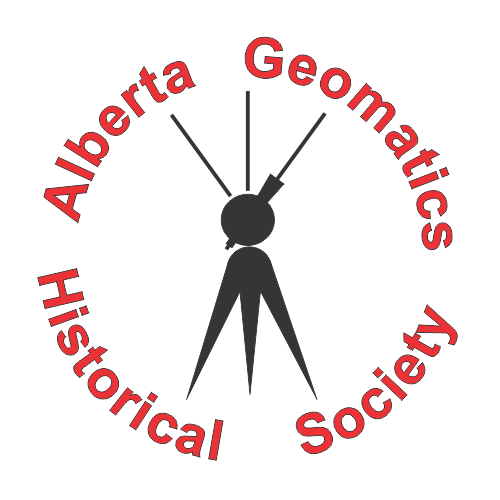
07. Chaining – an Art and a Science
By Gordon Olsson
Steel band tapes, when introduced, were called chains and the act of measuring using a steel band tape was referred to as chaining by surveyors. As the saying goes “old habits die hard.” With the introduction of the steel band tape, it was possible to obtain greater accuracy when chaining long distances – however knowledge, experience and skill were required.
The surveyor had a standard chain to which the field chains were frequently compared. A correction was required to compensate for any difference between the standard measure and the tape used in the field. Because steel band tapes will stretch, a tension handle was used when chaining in the field so that the same tension (usually twenty pounds) was used as when the chain was calibrated.
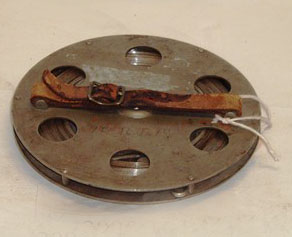
This is a DLS Standard Tape. It was used by surveyors to calibrate their working tapes. It is marked “Aspen 375 D.L.S. Standard 731, The Topley Co., Ottawa Made by The Lufkin Rule Co. of (not legible), Windsor, Ontario” The tape is calibrated in links on one side to 100 links and on the other side in feet to 50 feet. The reel is marked “WDU #26, Patented August 18, 1903”
Donated by A.J. Edwards, ALS
ALSA 2006.27.01

Tension handle.
Donated by Don George, ALS
ALSA 2008.09.04
Steel tapes expanded or contracted with temperature changes and, therefore, a temperature correction was required. Usually, chainmen[1] had a table showing the correction to be applied to the length measured at different temperatures. A difference of 20 degrees from the standard temperature of 65 degrees for a distance of 1,000 feet is about .14 of a foot.
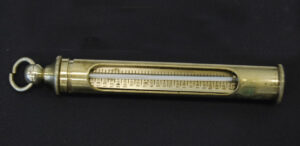
This thermometer is made by C.F. Casella & Co. Ltd. London. The Casella company’s roots go back to 1805.
Donated by C.H. Weir, ALS
ALSA 2007.27.03
When measuring up or down a slope, long distances could be measured in parts with the chain held level, or the full length of the chain could be used with the slope distance measured with an Abney or Locke pocket level clinometer. Knowing the slope of the chain enabled the horizontal distance to be determined. For small inclines, the correction was usually obtained from a slope correction table.

There is no manufacturer’s name on this clinometer.
Ed Scovill Estate
SHF 2018.01.10
Chaining pins, also called tally pins, were used in chaining. In laying out the township system, the front chainman marked the position on the ground of the 0-link mark at the start of the chain. That is where the rear chainman placed the 100-link mark of the chain for the next leg of the measurement. Eleven pins were required to measure 10 chains, or 660 feet, as the last pin placed was left in for the next leg.
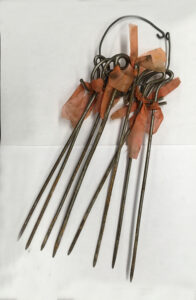
Set of eight chaining pins. Normally there are 11.
Donated by Murray Ingalls, ALS
ALSA 2008.16.05
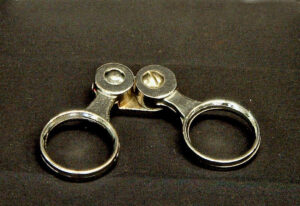
Chaining Clamps
Donated by Don George, ALS
ALSA 2007.31.03

Chaining clamps marked “Rabone, Birmingham, Made in England”
Donated by Monroe Kinloch, ALS
ALSA 2008.03.08
In addition to the corrections mentioned above, chainmen had to account for sag which resulted from an unsupported tape hanging in a catenary curve. The amount of correction required was difficult to determine as it was dependent on the weight of the tape, the length of the unsupported part of the tape and the amount of tension applied. Individual sag correction tables were prepared for each tape. As the amount of correction increased exponentially with the length of the tape unsupported, it was desirable to support the tape as much as possible throughout its length. Measuring over uneven ground or where there were obstructions on line necessitated the use of a plumb bob, which required a steady hand. Factors such as wind also affected the length. Chaining was truly an art and a science.

Tapes were often broken in the field and needed to be repaired. This was the ultimate in tape repair kits. It contained various pieces of steel tapes, a hammer, tin snips, rivets, a punch and several other items.
Donated by Bev Cheetham, ALS
ALSA 2016.04.08
Author: Gordon Olsson, ALS (Hon. Life)
November 9, 2021
Copyright 2024 © Alberta Geomatics Historical Society
[1] Today the term chainperson or chainpersons would invariably be used.
